Podcast: Play in new window | Download
This week, I make an easy pilaf with Middle Eastern flavors: dates and cinnamon, plus salty feta. Green beans pickled with dill and garlic are on the side, and for dessert, we have a quick trick for making strawberries taste their best. It’s all quite quick, and ideal for hot weather, when you don’t want the stove on for too long.
Click to play this episode in a new window; right-click to download
Subscribe via iTunes
Subscribe via RSS
Shopping list
Butter or olive oil (at least 2 tbsp)
Feta cheese (about 1/4 pound, or less, depending on your taste)
1 medium onion
2-4 cloves garlic
Bunch parsley
Bunch dill (or dried dill, if you happen to have that)
Green beans (several big handfuls, about 3/4 lb.)
Strawberries (6 or so big ones)
Large dates (about 6)
Ground cinnamon and/or cinnamon sticks
Ground allspice and/or whole berries
Pinch red pepper flake
Pine nuts or almonds (at least 1/4 cup)
Bulgur (no. 2 grind, ideally, about 1 1/2 cups)
Cider vinegar (at least 1/3 cup)
Balsamic vinegar (just 1 tsp)
Sugar (a pinch)
Honey (1/2 tsp)
Date-and-Cinnamon Bulgur Pilaf
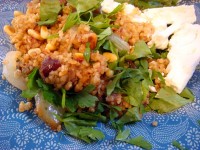 I got the basic idea for this pilaf from the excellent Moosewood Cookbook Cooks at Home, which I recommend as a good beginner cookbook even if you don’t happen to be vegetarian. (See my blog, Roving Gastronome, for more about what’s great about the book.) In that cookbook, the base is precooked rice, and that works very well. I just like the chewy texture of bulgur, and it cooks very quickly. You can use whatever combination of ground or whole spices you happen to have.
I got the basic idea for this pilaf from the excellent Moosewood Cookbook Cooks at Home, which I recommend as a good beginner cookbook even if you don’t happen to be vegetarian. (See my blog, Roving Gastronome, for more about what’s great about the book.) In that cookbook, the base is precooked rice, and that works very well. I just like the chewy texture of bulgur, and it cooks very quickly. You can use whatever combination of ground or whole spices you happen to have.
For about 4 servings
1-2 tbsp butter or olive oil
1 medium onion
Pinch salt
6 large dates
Large pinch ground cinnamon, plus 1 or 2 cinnamon sticks (optional)
Pinch ground allspice, plus 5 or 6 whole allspice berries (all optional)
1 1/2 cups bulgur (no. 2 grind, ideally)
2 1/4 cups water
Large handful pine nuts or almonds
Large handful parsley
Feta cheese, however much you like (goat cheese also works)
In a heavy saucepan with a tight-fitting lid, melt your butter or heat your olive oil over medium heat. Slice up your onion and toss it in, along with a generous pinch of salt. While the onions are softening up, slice up your dates into smallish bite-size pieces, then toss them in with the onions. Add the cinnamon and allspice and stir. Once the onions are soft and translucent, pour in the bulgur and stir to coat with oil (add a tiny bit more if you need to). Then pour in the water, give a good stir and put the lid on. Let the mix come to a boil, then turn down to the lowest simmer.
While the bulgur is simmering, chop your parsley coarsely. In heavy skillet over high heat, toast the pine nuts until just golden brown; immediately remove from the hot pan when they’re done. Set out your feta (or goat) cheese.
Check your bulgur after about 10 minutes. You want it to be chewy, and all of the water should be absorbed–if it’s still crunchy, put the lid back on for another minute or two. A lot depends on the weight of your pot and the flame on your stove. It’s OK if the bottom layer gets a bit dried and stuck to the bottom of the pot, but be careful not to let it scorch. If the bulgur is sticking and the texture is good, but the whole mix is still a bit moist, turn off the heat, fluff the bulgur up with a fork and leave the lid off for a few minutes, to let some of the steam dissipate.
Serve with parsley (you can mix it in with the bulgur, or sprinkle it on each serving) and toasted pine nuts–sprinkle these over the top, so they don’t get soggy. Set a slab of feta cheese on the side, or crumble it over the top.
Leftovers are good at room temperature; be sure to store any extra pine nuts separately, so they keep their texture.
Quick-Pickled Green Beans
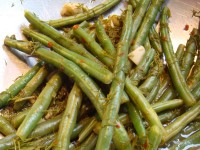 This is a great, simple treatment for green beans, and works for other crispy or relatively firm vegetables as well. You can vary the herbs and spices that go in as well–though if you had many more spices, you should probably remove the green herbs altogether, or the flavors will get too muddled. Dried herbs can work nearly as well as fresh–if you’re using them, add them to the vinegar mix just at the end of the boiling, so they get a bit rehydrated.
This is a great, simple treatment for green beans, and works for other crispy or relatively firm vegetables as well. You can vary the herbs and spices that go in as well–though if you had many more spices, you should probably remove the green herbs altogether, or the flavors will get too muddled. Dried herbs can work nearly as well as fresh–if you’re using them, add them to the vinegar mix just at the end of the boiling, so they get a bit rehydrated.
For about 3 side servings
2-3 large handfuls green beans (about 1 lb.)
Large handful fresh dill (or 1 heaping tbsp dried dill)
3 or 4 garlic cloves, peeled and roughly crushed (or 2 garlic cloves, peeled and minced fine or pressed)
Large pinch red pepper flake (optional)
About 1/3 cup cider vinegar (or other fruity variety)
Small dab honey or sugar, less than 1/2 teaspoon
Set large pot of generously salted water on to boil. Rinse beans and snap stem ends off; remove tips if soft. Rinse dill and chop coarsely; set in a large stainless-steel bowl. Boil beans for about 1 minute, until bright green and just barely soft, then set in bowl with dill.
While beans are boiling, combine garlic, red pepper, vinegar and honey in a small nonreactive (stainless steel) saucepan and boil for 1-2 minutes. Pour hot liquid over beans and dill, stir to combine and set aside for at least 10 minutes. Taste for salt right before serving–it may need a little extra. The flavor will develop the longer they sit, and they keep for several days in the fridge.
Macerated Strawberries
 This is an excellent treatment for good strawberries, and it also helps save ones that aren’t quite as good as they should be. For two people, simply wash, trim and roughly slice about six big strawberries. Place in a bowl and dust with a small amount of sugar–only about 1/2 tsp. Then sprinkle over about 1 teaspoon balsamic vinegar, just enough to coat the berries. (If in doubt, add less, not more–there should just be a slight slick of vinegar in the bowl, not a pool in the bottom.)
This is an excellent treatment for good strawberries, and it also helps save ones that aren’t quite as good as they should be. For two people, simply wash, trim and roughly slice about six big strawberries. Place in a bowl and dust with a small amount of sugar–only about 1/2 tsp. Then sprinkle over about 1 teaspoon balsamic vinegar, just enough to coat the berries. (If in doubt, add less, not more–there should just be a slight slick of vinegar in the bowl, not a pool in the bottom.)
Let sit for at least 20 minutes, but not more than a couple of hours. The strawberries will give off some of their juices–combined with the sugar and vinegar, it makes a very light syrup. The strawberries are great on ice cream, or with Greek yogurt.
Note: In the podcast, I use a bit of oxymeli, rather than balsamic vinegar. It’s extremely delicious, and more complex, but I’m not sure the stuff is easily available. Still, if you happen to see it, it’s an intriguing treat…






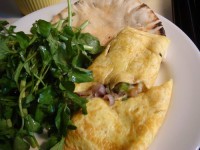
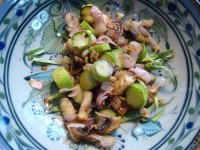
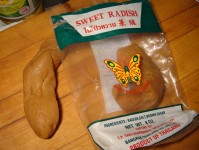
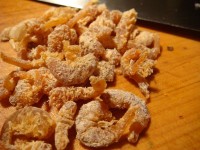
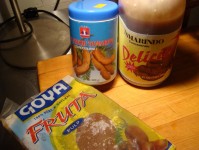

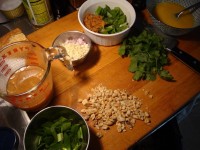
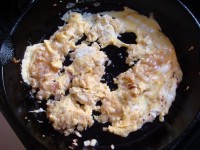
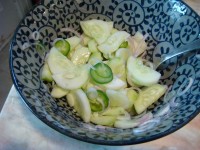
 Pad Thai
Pad Thai
